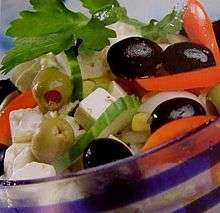Mediterranean cuisine
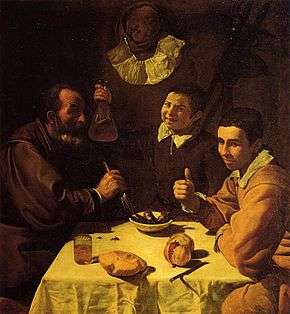
Mediterranean cuisine is the food from the lands around the Mediterranean Sea and its preparation. This geographical area broadly follows the distribution of the olive tree, which provides one of the most distinctive features of the region's cooking, olive oil.
The region's food came to be seen as a more or less unified cuisine following the cookery writer Elizabeth David's book, A Book of Mediterranean Food (1950). Other writers, such as the Tunisian historian Mohamed Yassine Essid, have agreed with David, defining the three core elements of the cuisine as the olive, wheat, and the grape, yielding oil, bread and pasta, and wine, respectively.
The region spans a wide variety of cultures with distinct cuisines, in particular the Italian, Levantine, Maghrebi, Ottoman / Greek, Provençal (French), and Spanish. However, the historical connections of the region, as well as the impact of the Mediterranean Sea on the region's climate and economy, mean that these cuisines share dishes beyond the core trio of oil, bread, and wine, such as roast lamb or mutton, meat stews with vegetables and tomato (for example, Spanish andrajos and Italian ciambotta), and the salted cured fish roe, bottarga, found across the region.
The cooking of the area is not to be confused with the Mediterranean diet, made popular because of the apparent health benefits of a diet rich in olive oil, wheat and other grains, fruits, vegetables, and a certain amount of seafood, but low in meat and dairy products. Mediterranean cuisine encompasses the ways that these and other ingredients, including meat, are dealt with in the kitchen, whether they are healthgiving or not.
Geography

By city and country
The cookery writer Elizabeth David's introduction to A Book of Mediterranean Food (1950) defines her scope as "the cooking of the Mediterranean shores". She sketches out the geographical limits as[2]
from Gibraltar to the Bosphorus, down the Rhone Valley, through the great seaports of Marseilles, Barcelona, and Genoa, across to Tunis and Alexandria, embracing all the Mediterranean islands, Corsica, Sicily, Sardinia, Crete, the Cyclades, Cyprus (where the Byzantine influence begins to be felt), to the mainland of Greece and the much disputed territories of Syria, the Lebanon, Constantinople, and Smyrna.[2]
By a key culinary plant

David defines the region as coextensive with the range of the olive tree: "those blessed lands of sun and sea and olive trees".[2] The olive's natural distribution is limited by frost and by availability of water. It is therefore constrained to a more or less narrow zone around the Mediterranean Sea, except in the Maghreb and in Spain, where it is distributed more widely, and on the islands of the Mediterranean, where it is widespread. It does not grow in most of France, most of the north of Italy (except Liguria), or the inland regions of the Balkans.[1][2]
The Tunisian historian Mohamed Yassine Essid similarly defines the region by the olive's presence, along with bread, wheat, and the grape as the "basic products of Mediterranean folk cuisine":[3]
Mediterranean cuisine is defined by the presence of fundamental elements which are said to play a more important role than others, reflecting a community of beliefs and practices which transcend religions, languages and even societies. The olive tree, the emblematic tree on more than one account, traces the bounds of a frontier of landscapes and lives on either side of which the Mediterranean begins or ends. Above Montelimar, nicknamed "Gates of Provence", is the limit of the olive.[3]
Key ingredients
Essid, as already mentioned, identifies the "trinity" of basic ingredients of traditional Mediterranean cuisine as the olive, wheat, and the grape, yielding oil, bread, and wine respectively.[3] The archaeologist Colin Renfrew calls this the "Mediterranean triad".[4]
Olive
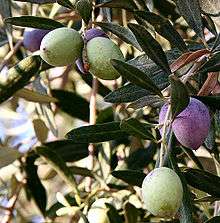
The olive appears to come from the region of Persia and Mesopotamia, at least 6,000 years ago.[5] It spread from there to nearby areas, and has been cultivated since the early Bronze Age (up to 3,150 BC) in southern Turkey, the Levant, and Crete.[6][7] The ten countries with the largest harvests (in 2011) are all near the Mediterranean (Portugal being the tenth largest): together, they produce 95% of the world's olives.[8]
The olive yields bitter fruits, made edible by curing and fermentation, and olive oil. Some 90% of the fruit production (1996) goes into olive oil.[9] The Mediterranean region accounts for the world's highest consumption of olive oil: in 2014, the highest-consuming country, Greece, used 17 kg[lower-alpha 1] per head; Italy, 12 kg, Spain 3 kg; the United States for comparison used only 1 kg per head.[10]
Wheat
Wheat was domesticated in the Fertile Crescent, in and near the Levant some 10,000 years ago. Its ancestors include wild emmer wheat; this was hybridised, harvested and sown to create domestic strains with larger grains, in ears that shatter less readily than wild forms.[11] It had been spread across the Mediterranean region as far as Spain by 5,000 BC.[12]
Wheat is a staple food in the Mediterranean region. Wheat bread was already critically important in the empire of Ancient Rome, which included the entire region; at that time, around 2,000 years ago, North Africa was the "breadbasket" of the empire.[13][14] Other staple wheat-based Mediterranean foods include pasta and semolina (wheat middlings) products such as couscous and burgul.[15] In turn, these are made into dishes such as the Greek dessert galaktoboureko (milk börek), consisting of filo pastry parcels around a custard made with semolina.[16] A widespread wheat dish from Turkey and the Levant to Iran and India is halva, a dessert of sweetened semolina with butter, milk, and pine kernels.[17]
Grape
The grape was domesticated between 7,000 and 4,000 BC between the Black Sea and Persia; archaeological evidence shows that wine was being made there by 6,000 BC, reaching Greece and Crete in the fifth millennium BC and Spain by the last millennium BC. Winemaking started in Italy in the ninth century BC, and in France around 600 BC.[18]
Grapes are grown for making wine, for drying as raisins, or for eating as table grapes. Wine grapes are often rich in tannins, while raisins and table grape varieties are chosen for their flavour.[19] Grape production remains important in the Mediterranean area, with a large part of the world's harvest. Italy produced 8 million tonnes (mt) in 2013; Spain 7.5 mt; France 5.5 mt; Turkey 4.0 mt; Egypt 1.4 mt; Greece 0.9 mt; Algeria 0.6 mt.[20] Wine production is similarly large, with France 4.3 mt; Italy 4.1 mt; Spain 3.2 mt, but with much lower figures from the Muslim countries.[20]
History
Concept
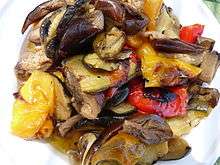
The concept of a Mediterranean cuisine is very recent, probably dating from the publication of David's A Book of Mediterranean Food (1950).[21] David herself did not use the term, speaking instead of Mediterranean "food", "cookery", or "cooking".[22] The usefulness of the concept is disputed. Carol Helstosky, author of the book Food Culture in the Mediterranean (2009), is among the authors who use "Mediterranean cuisine" interchangeably with "Mediterranean food". In the preface to her book she writes[23]
Mediterranean food is incredibly popular: pasta, pizza, gyros,[lower-alpha 2] kebab, and falafel can be found just about everywhere. Food experts and cookbook authors adore Mediterranean cuisine ...[23]
Essid acknowledges that "geographical differences and the vicissitudes of history" have affected the food of different Mediterranean lands, but nonetheless asserts that:[24]
Rules for the preparation and consumption of food are common to the lands that border the Mediterranean. They offer both stability, continuity and reproduction of a specific pattern of eating which resists conquest, invasion, colonisation, social change, industrialisation and urbanisation. Consequently, wherever you go, in southern Europe or the lands bordering the southern Mediterranean, you will find a cuisine and gastronomic ritual which is always familiar.[24]
On the other hand, Sami Zubaida argues in his book Culinary Cultures of the Middle East (1994) that:[25]
The idea of the "standard Mediterranean" ... is a modern construction of food writers and publicists in Europe and North America earnestly preaching what is now thought to be a healthy diet to their audiences by invoking a stereotype of the healthy other on the shores of the Mediterranean. Their colleagues in Mediterranean countries are only too willing to perpetuate this myth. The fact of the matter is that the Mediterranean contains varied cultures.[25]
The cookery author Clifford A. Wright wrote in 1999: "There really is no such thing as 'Mediterranean cuisine'. At the same time, we seem to know what we mean when we use the expression ..."[26] Wright argued that David's book itself was largely about specifically French Mediterranean food, pointing out that "only 4 percent of her recipes come from North Africa or the Levant".[27]
Since David's time, a variety of books on Mediterranean cuisine have been written, including Helstosky's 2009 book, already mentioned; books by other cookery writers include S. Rowe's Purple Citrus and Sweet Perfume: Cuisine of the Eastern Mediterranean (2011); Mari-Pierre Moine's Mediterranean Cookbook (2014); and J. R. Stevens' Mediterranean Cuisine (2015). There are many more cookbooks covering specific cuisines in the Mediterranean area, such as B. Santich's The Original Mediterranean Cuisine: Medieval Recipes for Today (1995), on Catalan and Italian recipes; H. F. Ullman's on the cooking of Tunisia (2006),[28] Spain[29] and Italy,[30] each one subtitled "Mediterranean Cuisine".
Origins
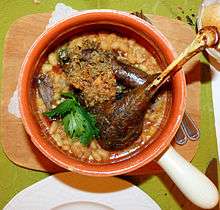
The ingredients of Mediterranean cuisine are to an extent different from those of the cuisine of Northern Europe, with olive oil instead of butter, wine instead of beer. The list of available ingredients has changed over the centuries. One major change was the introduction of many foods by the Arabs to Portugal, Spain and Sicily in the Middle Ages.[31] Those foods included aubergines, spinach, sugar cane, rice, apricots and citrus fruits, creating the distinctive culinary tradition of Al-Andalus.[32]
Another major change was the arrival of foods from the Americas in Early Modern times (around the sixteenth century), notably the incorporation of the potato into Northern European cuisine,[lower-alpha 3] and the eager adoption of the tomato into Mediterranean cuisine. The tomato, so central now to that cuisine, was first described in print by Pietro Andrea Mattioli in 1544. Similarly, many of the species of Phaseolus beans now used around the Mediterranean, including P. vulgaris (the French or haricot bean), were brought back from the Americas by Spanish and Portuguese explorers.[31][34][35][36]
Cooking
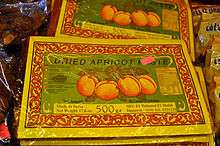
David's introduction to her 1950 book characterises the cooking of the Mediterranean countries as "conditioned naturally by variations in climate and soil and the relative industry or indolence of the inhabitants."[2]
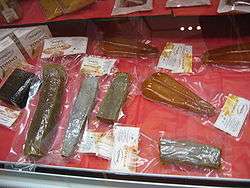
David identifies "the ever recurring elements" in the food of this extensive region as olive oil, saffron, garlic, "pungent" local wines, as well as the "aromatic perfume" of herbs, especially rosemary, wild marjoram, and basil, and the bright colours of fresh foods in the markets, "pimentos, aubergines, tomatoes, olives, melons, figs" and "shiny fish, silver, vermilion, or tiger-striped". She includes cheeses of "sheep's or goat's milk", "figs from Smyrna on long strings" and "sheets of apricot paste which is dissolved in water to make a cooling drink."[2]

With common ingredients including the olive, wheat, and grape; a shared climate; and a long period for cultural exchange, it might be expected that a single, pan-Mediterranean cuisine would have developed. Certain items, such as olive oil,[3] bread,[3] wine,[3] roast lamb or mutton[38] (for example, Maghreb méchoui, Greek kleftiko and souvlaki, Turkish shish kebab), bottarga,[37][39] and stews of meat with vegetables and tomato (such as Spanish andrajos, French estouffade à la Provençale,[40] Italian ciambotta, Turkish buğu kebabı), are indeed found all around the Mediterranean. Despite this, however, the lands bordering the Mediterranean sea have distinct regional cuisines, from the Maghreb, Levant and Ottoman to the Italian, French, and Spanish. Each of those, in turn, has national and provincial variations.[41]
Maghrebi
Maghrebi cuisine includes the cuisines of Algeria, Libya, Morocco, and Tunisia. One of the most characteristic dishes of the region is couscous, a steamed, small-grained wheat semolina, served with a stew. The dish is ancient, mentioned by the Medieval traveller Ibn Battuta, and found for example also in Italian cuisine, at Genoa, Livorno and Trapani.[42][43]
One stew that may be served with couscous is the Moroccan tagine, a hearty, somewhat dry dish of meat and vegetables, cooked slowly in a pot (called a tagine) with a tall conical lid. Dishes from the Maghreb region of North Africa are often coloured and flavoured with the hot spice mixtures harissa and ras el hanout (containing such spices as cumin, coriander, saffron, cinnamon, cloves, chillies, and paprika). Other characteristic flavourings of the region are preserved lemons and dried apricots and raisins.[38]
Levantine
Levantine cuisine is the cooking of the Levant (including the Middle Eastern Mediterranean coast, east of Egypt). Among the most distinctive foods of this cuisine are traditional small meze dishes such as tabbouleh, hummus, and baba ghanoush.[44][45] Tabbouleh is a dish of bulgur cracked wheat with tomatoes, parsley, mint and onion, dressed with olive oil and lemon juice.[46][47] Baba ghanoush, sometimes called "poor man's caviar", is a puree of aubergine with olive oil, often mixed with chopped onion, tomato, cumin, garlic, lemon juice, and parsley. The dish is popular across the whole of the Eastern Mediterranean and North Africa.[48]
Ful medames, originally from Egypt and still a national dish there, consists of fava beans with oil and cumin; it is popular throughout the Levant.[49] The dish may be ancient: dried beans of Neolithic age have been found near Nazareth.[50]
Ottoman

Ottoman cuisine has given rise to the cuisines of modern Turkey, parts of the Balkans, Cyprus, and Greece. A distinctive element is the family of small flaky pastries called börek. These are popular and widespread across the Eastern Mediterranean region, and date as far back as ancient Roman times. Börek are made of thin sheets of filo pastry, filled with mixtures such as meat, caramelised onion and sweet peppers.[51][52]
Another widespread[lower-alpha 4] and popular dish is moussaka, a baked dish of aubergine or potato with various other ingredients: often minced meat and tomatoes, sometimes a layer of egg custard or béchamel sauce on top. In its Greek variant, well-known outside the region, it includes layers of aubergine and minced meat with custard or béchamel sauce on top, but that version is a relatively recent innovation, introduced by the chef Nikolaos Tselementes in the 1920s.[54]
Greek
Much of Greek cuisine is part of the larger tradition of Ottoman cuisine, the names of the dishes revealing Arabic, Persian or Turkish roots: moussaka, tzatziki, yuvarlakia, keftethes, boureki, and so on. Many dishes' names probably entered the Greek vocabulary during Ottoman times, or earlier in contact with the Persians and the Arabs. However, some dishes may be pre-Ottoman, only taking Turkish names later; Ash and Dalby, for example, speculate that grape-leaf dolmadhes were made by the early Byzantine period. Greek cookery makes wide use of vegetables, olive oil, grains, fish, wine and meat (white and red, including lamb, poultry, rabbit and pork). Other important ingredients include olives, cheese, aubergin), courgette, lemon juice, vegetables, herbs, bread and yoghurt. Some dishes can be traced back to ancient Greece: lentil soup, fasolada, retsina (white or rosé wine flavoured with pine resin) and pasteli (sesame seeds baked with honey); some to the Hellenistic and Roman periods: loukaniko (dried pork sausage); and Byzantium: feta cheese, avgotaraho (bottarga) and paximadhia (rusk).[55][56]
Italian

Mediterranean Italian cuisine includes much of Italy outside the north and the mountainous inland regions. It is a diverse cuisine, but among its best-known and most characteristic foods are risotto, pizza in Neapolitan and Sicilian styles, and pasta dishes such as spaghetti.[57][58][59]
Risotto is a dish made using Italian short-grain rice, which is both highly absorbent and resistant to turning into a pudding when cooked with stock and flavoured with onions and garlic, cooked in butter.[57] Anna Gosetti della Salda's book of Italian regional cookery lists 37 risotto recipes, 18 of them from the Veneto. Variations among Veneto risottos include additions of fish and white wine; chicken; eel; mushrooms and grated Parmesan cheese; quails; small pieces of beef; courgettes (zucchini); clams; Ragù; beans; mussels; prawns; cuttlefish; and asparagus.[60]
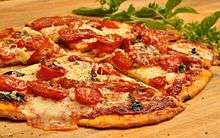
Pizza, or as David notes "pissaladina or pissaladière" in Provence (the cuisines of Mediterranean France and Italy having something in common), is a piece of bread dough rolled out thin, with a topping which varies from place to place, but is generally much simpler than those in the English-speaking world.[61][62] In Naples this is tomato, anchovies and buffalo mozzarella. In San Remo it is onions cooked in olive oil, with salted sardines. The Provençal variety uses onions, black olives, and anchovies.[58]
Spaghetti dishes also vary. It may be eaten as David says "simply with olive oil and garlic", without cheese, or with a sauce of "very red and ripe peeled tomatoes", cooked briefly and flavoured with garlic and either basil or parsley. One Sicilian variant includes pieces of bacon, onions fried in fat, garlic, stoned olives, and anchovies, served with olive oil and grated Parmesan cheese.[59]
French
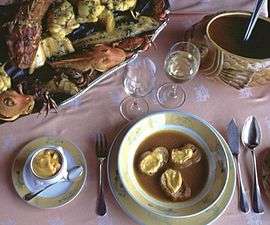
Mediterranean French cuisine includes the cooking styles of Provence, Occitania, and the island of Corsica. Distinctive dishes that make use of local ingredients include bouillabaisse and salade niçoise.[63][64]
Bouillabaisse is a substantial dish from the French port of Marseille, capital of Provence. It is a stew for at least eight people, because it should contain many kinds of fish such as crayfish, gurnard, weever, John Dory, monkfish, conger eel, whiting, sea bass, and crab. These are cooked with Mediterranean vegetables and herbs, namely onions, garlic, tomatoes, thyme, fennel, parsley, bay, and orange peel.[63][lower-alpha 5]
Salade niçoise is a colourful salad of tomatoes, tuna, hard-boiled eggs, Niçoise olives, and anchovies, dressed with a vinaigrette.[64]
Spanish
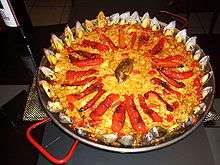
Spain's varied cuisine includes the cooking of Andalusia, Catalonia, Valencia, and the Balearic islands.[65] Paella is a characteristic Spanish dish, originally from Valencia and now popular across a much wider area, made in many versions. It may contain a mixture of chicken, pork, and shellfish, fried in oil in a large shallow pan, with vegetable flavourings, and long-grain rice cooked to absorb the water and coloured with saffron. Other local ingredients may include artichoke hearts, peas, sweet peppers, sausages and so on.[66]
Mediterranean diet and cuisine
The Mediterranean diet, popularised in the 1970s, is sometimes conflated with Mediterranean cuisine. Thus, the American Diabetes Association writes about "Mediterranean-Style Eating", mentioning "the traditional Mediterranean lifestyle ... of ... eating healthfully[lower-alpha 6] together among family and friends", and asserting that "Mediterranean cuisine is plant-based", citing the ingredients "whole grains, fruits, vegetables, herbs and spices, beans, nuts, seeds, and olive oil", and stating that most foods "in a Mediterranean diet come from plants".[68]
The 1984 travel guide Guida all'Italia gastronomica states that "around 1975, under the impulse of one of those new nutritional directives by which good cooking is too often influenced, the Americans discovered the so-called Mediterranean diet. The name even pleased Italian government officials, who made one modification: changing from diet—a word which has always seemed punitive and therefore unpleasant—to Mediterranean cuisine."[69]
"Mediterranean diet" as popularly understood may have little to do with either Mediterranean cuisine or indeed the traditional Mediterranean diet based on the trinity of wheat, olive, and grape. Thus, Judy Lance's book Low Carb Eating: How a Wheat Free Menu, or Mediterranean Diet Can Help with Weight Loss advocates a diet called Mediterranean, but lacking the wheat staple entirely.[70]
A changing cuisine

Since David wrote about Mediterranean food in 1950, and indeed since dietary researchers showed in the 1950s that people around the Mediterranean had less coronary heart disease than the peoples of northern Europe, the traditional Mediterranean ways of life and of eating have changed. Increased wealth and busy lives have led people to eat more meat and less vegetables: their diet is becoming more northern European, with more convenience foods and with less of a preventative effect on cardiovascular disease.[71]
Notes
- ↑ A kilogram is about 2.2 pounds in weight.
- ↑ The Greek version of döner, meat roasted on a vertical spit.
- ↑ Barrels of potatoes were exported from the Canary Islands to Antwerp in 1567.[33]
- ↑ Elizabeth David stated that "mousaká" was "well known all over the Balkans, Turkey, and the Middle East."[53]
- ↑ David's recipe is from M. Reboul's La Cuisinière Provençale.[63]
- ↑ For example, a 2013 study in America found that Mediterranean diet (with cuisine unspecified) supplemented with extra-virgin olive oil or nuts reduced the incidence of cardiovascular disease. Given that olive oil is a core part of the diet in the Mediterranean area, the mention of "supplemented with extra-virgin olive oil or nuts" indicates that the "Mediterranean diet" as understood in the study was different from that eaten in the Mediterranean countries.[67]
References
- 1 2 Oteros, Jose (2014). "Modelización del ciclo fenológico reproductor del olivo". Universidad de Córdoba (PhD Thesis). Retrieved 29 April 2016.
- 1 2 3 4 5 6 7 David, 1950, Introduction, pp. 16–17
- 1 2 3 4 5 6 Essid, 2012, p. 29
- ↑ Renfrew, Colin (1972). The Emergence of Civilization; The Cyclades and the Aegean in the Third Millennium B.C. Taylor & Francis. p. 280.
- ↑ Boskou, D., ed. (1996). Olive Oil. Chemistry and Technology. AOCS Press.
- ↑ Vossen, Paul (2007). "Olive Oil: History, Production, and Characteristics of the World's Classic Oils". HortScience. 42 (5): 1093–1100.
- ↑ Lanza, Fabrizia (2011). Olive: a global history. Reaktion. p. 15.
- ↑ FAOSTAT Archived January 18, 2013, at the Wayback Machine., 2011
- ↑ World Olive Encyclopedia. International Olive Council. 1996. ISBN 84-01-61881-9.
- ↑ Terazono, Emiko (14 January 2015). "Olive oil demand falls in Europe homelands". Financial Times. Retrieved 2 May 2016.
- ↑ Tanno, K. Willcox; Willcox, G. (2006). "How fast was wild wheat domesticated?". Science. 311 (5769): 1886. doi:10.1126/science.1124635. PMID 16574859.
- ↑ Jared Diamond (1997). Guns, Germs and Steel: A short history of everybody for the last 13,000 years. Viking. ISBN 0-09-930278-0.
- ↑ Essid, 2012. p. 51 and passim
- ↑ Abis, Sebastien (2012). "Wheat in the Mediterranean Region: Societies, Trade and Strategies" (PDF). International Centre for Advanced Mediterranean Agronomic Studies (CIHEAM). Retrieved 2 May 2016.
- ↑ Ozner, Michael (2014). The Complete Mediterranean Diet. Benbella Books. pp. 573–576. ISBN 978-1-939529-96-1.
- ↑ Stein, Rick. "Galaktoboureko with orange syrup". BBC. Retrieved 2 May 2016.
- ↑ "Divine Semolina Dessert - Suji Halva". Food.com. Retrieved 2 May 2016.
- ↑ This, Patrice; Lacombe, Thierry; Thomash, Mark R. (2006). "Historical Origins and Genetic Diversity of Wine Grapes". Trends in Genetics. 22 (9): 511–519. doi:10.1016/j.tig.2006.07.008. PMID 16872714. More detail is given in Evolution and history of grapevine (Vitis vinifera) under domestication: new morphometric perspectives to understand seed domestication syndrome and reveal origins of ancient European cultivars.
- ↑ Sauer, Jonathan D. (1993). Historical Geography of Crop Plants: A Select Roster. CRC Press. pp. 167–174. ISBN 978-0-8493-8901-6.
- 1 2 "Production Quantities by Country 2013". FAOSTAT. Retrieved 2 May 2016.
- ↑ Wright, p. xv
- ↑ David, 1950, whole book
- 1 2 Helstosky, 2009. p. x
- 1 2 Essid, 2012. p. 51
- 1 2 Sami Zubaida, "National, Communal and Global Dimensions in Middle Eastern Food Cultures" p. 43 in Sami Zubaida and Richard Tapper, [A Taste of Thyme:] Culinary Cultures of the Middle East, London and New York, 1994 and 2000, ISBN 1-86064-603-4. The book has been published with and without the "A Taste of Thyme" prefix.
- ↑ Clifford A. Wright, A Mediterranean Feast: The Story of the Birth of the Celebrated Cuisines of the Mediterranean from the Merchants of Venice to the Barbary Corsairs, with More than 500 Recipes, 1999, ISBN 0-688-15305-4, p. 1
- ↑ Clifford Wright, A Mediterranean Feast, Introduction, note 2: "it really is not about Mediterranean food but rather about French food"
- ↑ Ullman, H. F. (2006). Tunisia (Mediterranean Cuisine). Konemann. ISBN 978-3-8331-2344-3.
- ↑ Ullman, H. F. (2006). Spain (Mediterranean Cuisine). Konemann. ISBN 978-3-8331-2035-0.
- ↑ Ullman, H. F. (2006). Italy (Mediterranean Cuisine). Konemann. ISBN 978-3-8331-2031-2.
- 1 2 Schwabe, Calvin W. (1979). Unmentionable Cuisine. University of Virginia Press. p. 414. ISBN 978-0-8139-1162-5.
- ↑ "Arab Influence". Spanish Food. Retrieved 28 April 2016.
- ↑ Hawkes, J. G.; Francisco-Ortega, J. (1993). "The early history of the potato in Europe". Euphytica. 70 (1): 1–7. doi:10.1007/BF00029633.
- ↑ Smith, A. F. (1994). The Tomato in America: Early History, Culture, and Cookery. University of South Carolina Press. p. 13. ISBN 1-57003-000-6.
- ↑ Kaplan, Lawrence (1965). "Archeology and Domestication in American Phaseolus (Beans)". Economic Botany. 19 (4): 358–368. doi:10.1007/bf02904806. JSTOR 4252645.
- ↑ Hayes, Dayle; Laudan, Rachel (2009). Food and Nutrition. Marshall Cavendish. p. 646. ISBN 978-0-7614-7825-6.
- 1 2 Coroneo, V. (2009). Brandas, V., Sanna, A., Sanna, C., Carraro, V., Dessi, S., Meloni, M.. "Microbiological characterization of botargo. Classical and molecular microbiological methods". Industrie Alimentari. 48 (487): 29–36.
- 1 2 "An Introduction to Mediterranean Cuisine". TableAgent. Retrieved 28 April 2016.
- ↑ Virbila, S. Irene (7 September 2013). "Bottarga, a briny Mediterranean delicacy worth smuggling". Los Angeles Times. Retrieved 1 May 2016.
Bottarga is hardly a new ingredient: It has been traded up and down the Mediterranean for thousands of years.
- ↑ David, Elizabeth (1980) [1951]. French Country Cooking. Dorling Kindersley [John Lehmann]. pp. 121–122.
- ↑ Nestle, Marion (1995). "Mediterranean diets: historical and research overview". American Journal of Clinical Nutrition. 61 (supplement): 131S–1320S.
- ↑ Naylor, Phillip C. (2015). Historical Dictionary of Algeria. Rowman & Littlefield. p. 195. ISBN 978-0-8108-7919-5.
- ↑ Soletti, Francesco; Selmi, Luca (2006). Turismo gastronomico in Italia, Volume 1. Touring Club Italiano. p. 250.
- ↑ Burum, Linda (October 2005). Los Angeles Magazine. Emmis Communications. p. 186.
- ↑ Davidson, Alan (2014). The Oxford Companion to Food. Oxford University Press. p. 44. ISBN 978-0-19-967733-7.
- ↑ Sami Zubaida, "National, Communal and Global Dimensions in Middle Eastern Food Cultures" in Sami Zubaida and Richard Tapper, A Taste of Thyme: Culinary Cultures of the Middle East, London and New York, 1994 and 2000, ISBN 1-86064-603-4, p. 35, 37; Claudia Roden, A Book of Middle Eastern Food, p. 86; Anissa Helou, Oxford Companion to Food, s.v. Lebanon and Syria; Maan Z. Madina, Arabic-English Dictionary of the Modern Literary Language, 1973, s.v. تبل
- ↑ Oxford Companion to Food, s.v. tabbouleh
- ↑ Cotter, Charis (2008). One Thousand and One Foods. Pavilion. p. 46. ISBN 978-1-86205-785-2.
- ↑ McCann, James C. (2009). Stirring the Pot: A History of African Cuisine. Ohio University Press. p. 99.
- ↑ Marks, Gil (2010). Encyclopedia of Jewish Food. Wiley. p. 191.
- ↑ Davidson, Alan (2014). The Oxford Companion to Food. Oxford University Press. p. 95. ISBN 978-0-19-967733-7.
- ↑ Marcoux, P. (2014). Cooking with Fire. Storey. p. 105. ISBN 978-1-61212-158-1.
- ↑ David, 1988. p. 43
- ↑ Kremezi, Aglaia (13 July 2010). "'Classic' Greek Cuisine: Not So Classic". The Atlantic.
- ↑ Dalby, Andrew (1996). Siren Feasts: A History of Food and Gastronomy in Greece. Routledge. p. 190. ISBN 0-415-11620-1.
- ↑ Ash, John (2006). A Byzantine Journey. Tauris Parke. ISBN 978-1-84511-307-0.
- 1 2 David, 1950, pp. 101–103
- 1 2 David, 1950, pp. 45–46
- 1 2 David, 1950, pp. 109–111
- ↑ Gosetti della Salda, Anna (1993). Le Ricette Regionali Italiane (11th ed.). Solares. pp. 377–384 and passim.
- ↑ Altomari, Dawn (2005). The Everything Italian Cookbook: 300 Authentic Recipes to Help You Cook Up a Feast!. Everything Books. p. 11. ISBN 1-59337-420-8.
- ↑ Smith, Andrew F. (2007). The Oxford Companion to American Food and Drink. Oxford University Press. p. 463. ISBN 978-0-19-988576-3.
- 1 2 3 David, 1950, pp. 66–68
- 1 2 "Recette de Salade niçoise traditionnelle". L'Atelier des Chefs. Retrieved 30 April 2016.
- ↑ "Regional Cuisine in Spain". Spain.info. 2016. Retrieved 2 June 2016.
- ↑ David, 1950, pp. 104–106
- ↑ Estruch, Ramón; Emilio, Ros (2013). "Primary Prevention of Cardiovascular Disease with a Mediterranean Diet". The New England Journal of Medicine. 368: 1279–1290. doi:10.1056/NEJMoa1200303.
- ↑ "The Basics of Mediterranean-Style Eating". The American Diabetes Association.
- ↑ Alberini, Massimo; Mistretta, Giorgio (1984). Guida all'Italia gastronomica. Touring Club Italiano. p. 37.
- ↑ Lance, Judy (2013). Low Carb Eating: How a Wheat Free Menu, or Mediterranean Diet Can Help with Weight Loss. Speedy Publishing. ISBN 978-1-63187-908-1.
- ↑ Rumm-Kreuter, D. (May 2001). "Comparison of the eating and cooking habits of northern Europe and the Mediterranean countries in the past, present and future". Int J Vitam Nutr Res. 71 (3): 141–148. doi:10.1024/0300-9831.71.3.141. PMID 11582834.
Sources
| Wikimedia Commons has media related to Mediterranean Cuisine. |
- David, Elizabeth (1988) [1950]. A Book of Mediterranean Food. Dorling Kindersley [John Lehmann].
- Essid, Mohamed Yassine (2012). Chapter 2. History of Mediterranean Food. MediTerra: The Mediterranean Diet for Sustainable Regional Development. Presses de Sciences Po. pp. 51–69. ISBN 978-2-7246-1248-6.
- Helstosky, C. (2009). Food Culture in the Mediterranean. Food culture around the world. Greenwood Press. ISBN 978-0-313-34626-2. 189 pages.
- Moine, Mari-Pierre (2014). Mediterranean Cookbook. Dorling Kindersley. ISBN 978-1-4093-4724-8.
- Stevens, J. R. (2015). Mediterranean Cuisine:Recipes from Southern Europe to the Middle East. CreateSpace. ISBN 978-1-5194-6111-7.
- Rowe, S. (2011). Purple Citrus and Sweet Perfume: Cuisine of the Eastern Mediterranean. HarperCollins. ISBN 978-0-06-210220-1. 256 pages.
- Santich, Barbara (1995). The Original Mediterranean Cuisine: Medieval Recipes for Today. Wakefield Press. ISBN 978-1-86254-331-7. 178 pages.
- Abu Shihab, Sana Nimer (2012). Mediterranean Cuisine. Authorhouse. ISBN 978-1-4772-8309-7.
.jpg)
